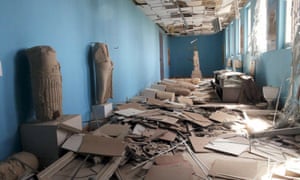
The first images to emerge from the ancient city of Palmyra after Syrian regime forces expelled Islamic State fighters have shown large swaths of destruction but also suggest that several important archaeological sites are intact. Photographs of the Unesco world heritage-listed citadel, known as “the bride of the desert”, taken following the recapture of the city by Bashar al-Assad’s troops show the damage made by Isis during its 10-month occupation.
The extremist group had destroyed some of Palmyra’s most treasured artefacts, including the Temple of Bel and the Arch of Triumph. However, some of Palmyra’s ruins appear to have survived, including the Agora and the celebrated Roman theatre.
Maamoun Abdelkarim, Syria’s antiquities chief, said authorities had been “expecting the worst”.
But he told Agence France-Presse that “the landscape, in general, is in good shape”.
Speaking to the Guardian, Abdelkarim said a team of archaeologists would go to Palmyra in the coming days to assess the damage to its monuments, and pledged to rebuild the destroyed temples and arch.
“We will issue a challenge to international terrorism, that no matter what you do you cannot erase our history, and we will not sit idle and weep over the ruins,” he said. Syrian regime soldiers entering the city echoed his comments, saying they were relieved to see that many key sites had endured.
“We were so scared we would enter the ruins and find them completely destroyed,” one Syrian soldier told AFP.
“We were afraid to look ... But when we entered and saw it, we were relieved,” he said. After driving Isis out of Palmyra’s old city, Syrian soldiers, pro-government militiamen, and Russian fighters strolled among the ruins in awe, amazed that they were still intact.
They walked slowly in fear of roadside bombs or hidden mines that Isis may have left behind, but their joy and relief was palpable.
But one Syrian fighter stood sobbing loudly in the old ruins. “I’m sad to see some of the old city destroyed, but I’m also weeping for my brother, who died in the battle here,” the soldier said. “By taking the city, I feel I’ve avenged his death.”
The modern district of Palmyra, where 70,000 people lived before the war, was not as lucky as the old city.
Days of heavy street fighting battered the rows of two- to three-storey apartment buildings, and some completely collapsed into a pile of rubble.
Isis seized Palmyra in May 2015. The fall of the city gained worldwide attention as it hosts some of the most well-preserved ruins of antiquity. As well as destroying the iconic temples of Bel and Baalshamin and the Arch of Triumph, the group looted graves and used the amphitheatre to stage executions.
Isis fighters also killed the archaeologist who had looked after the ruins for 40 years.
The militants were driven out of the city on Saturday by regime forces.
“We have restored security and stability to the city of Palmyra, and established full control on the surrounding, commanding hills,” the Syrian military said in its statement.
State TV said troops were working on clearing mines from the town and its monuments, where numerous booby traps were laid down by the militants before their retreat.
No comments:
Post a Comment